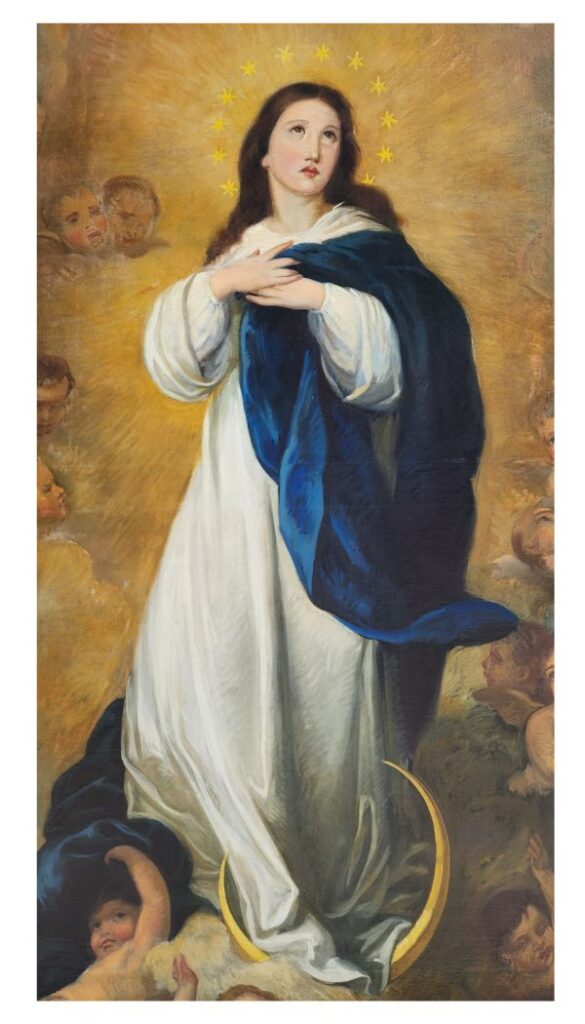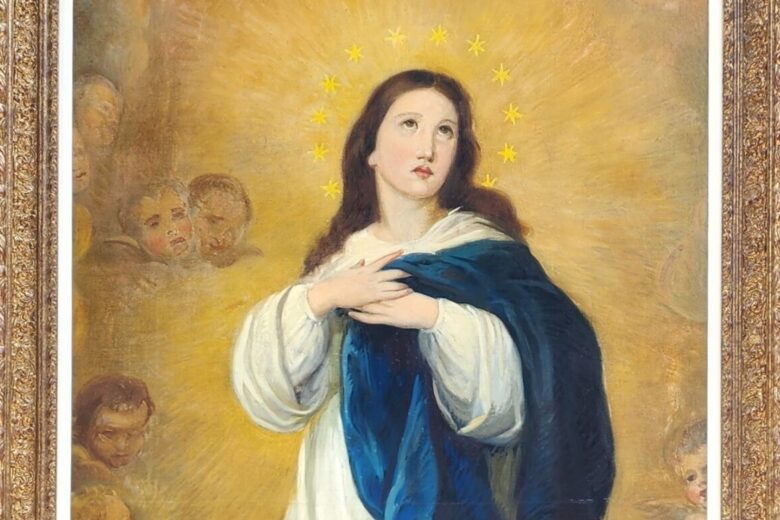As America celebrated fathers last weekend, there’s some irony in considering a painting of the most notable mother in human history, Mother Mary.
But first, the artist…
Johann Schmitt, a German-born painter, was one of many who immigrated to America in search of opportunity, adventure, and freedom in the middle of the 19th century. As America stretched her fledgling wings westward, Catholic communities grew along its rivers. But where would these families worship?
Bishops and religious orders sought to build grand churches and to fill them with art that reflected their European roots and traditions.
Schmitt took this thought to prayer: the eternal souls of the many men, women, and children who would be moving out west and who needed Jesus. He wasn’t a gifted speaker or storyteller, but he prayed God would still use him.
Not long after his arrival in New York City, Johann placed an advertisement in a Cincinnati Catholic newspaper that read, “A Painter of Real Catholic Art at Reasonable Prices.”
Before the ink could dry, Johann had several requests for commissions. He and his wife, Margaret, and their adopted daughter, Mary, were off to their new home in Covington, Kentucky.
The artist spent long days painting pieces for altars and murals on the walls of churches and cathedrals around Covington, Louisville, over to St. Louis, up through Indiana, and into the frontier of Wisconsin.
He left a trail of beauty that, like breadcrumbs, has been gobbled up by the bloated birds of time. Many of his works have been lost in fires, floods, and perhaps worst of all: forgotten.
Such was the case in my little town.
For decades, Johann Schmitt’s painting, The Immaculate Conception, was hidden behind a curtain. It had been covered because its appearance had been deemed unsightly, and its restoration too costly. No doubt the painting and its canvas’s integrity had been tested: it had first been painted for a parish in Louisville sometime around 1865.
That parish, St. Mary’s, was later razed due to structural instability, but had gifted everything still usable to mission churches and a local orphanage.
The old church in our town was one of those mission churches, and it was appropriately given a painting of its namesake, The Immaculate Conception. Time marched on, and the old church building was also no longer suitable due to flood damage and size.
Its new building was erected in 1959, and the painting (sans frame) was affixed to the wall with a sort of glue.
Johann had modeled his painting after the famed Immaculate Conception of Los Venerables by Bartolome Esteban Murillo. Mary is presented in a heavenly space with clouds and angels. The imagery includes her traditional blue and white dress, symbolizing her purity and her nearness to the divine as the daughter of God the Father, the mother of Jesus, and the spouse of the Holy Spirit. Her hands are gently crossed over her heart, a gesture of devotion and humility, silent echoes of her words in the Gospel of Luke, “I am the handmaid of the Lord,” (1:38). Golden light envelopes Mary, a crescent moon is beneath her feet, and twelve stars crown her in a Biblical reference to Revelation 12:1.
This is a visual declaration of faith in the Immaculate Conception, the Catholic dogma which declares that Mary was conceived without original sin. This unique grace was bestowed upon her by God in preparation for her role as the mother of our Lord.
As an adult Catholic-convert, I wrestled most with the Church’s teachings on Mary — particularly the Immaculate Conception. Didn’t Paul say that “all had sinned” (Romans 3:23), and Mary declare that her “spirit rejoices in God, my Savior” (Luke 1:47)?
The Catholic Church’s Catechism teaches that Mary was indeed saved by Christ, just in a more exalted fashion. Of course, there was an already the Big Exception to St. Paul’s “all” (Jesus), not to mention countless others (innocent babies). One question still lingered: Why?
If Sunday School in Eastern Kentucky taught me anything, it’s that the answer is always Jesus. Mary was preserved from the stain of sin because she was to be a Holy Tabernacle, the Ark of the New Covenant. Mary carried Christ.
Yes, it’s all for Jesus.
After much anticipation, my parish will soon reveal and celebrate its beautifully restored Immaculate Conception by Johann Schmitt. This proclamation of faith by the parish community has been a labor of love not for the past, but for future generations. The parish and wider community generously donated towards the restoration project.
As I look at the painting, I can’t help but think of the artist. Even though the painting was inspired by Murillo’s, Johann took one notable creative liberty. His daughter, Mary, frequently modeled for him. I imagine his eyes seeing the child’s innocence. As her father, he knew the young girl’s pure heart. Love and prayers dripped from Johann’s brush as he painted her eyes turned to Heaven.
It makes me think of the best of fathers, the Good Father who created all of us. The Father who knows us and loves us. The Father who delights in life and miracles and continues to create new souls every day.
To the Eternal Father, ever-present and forever worthy of all glory, honor and praise.

